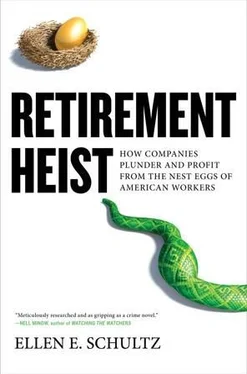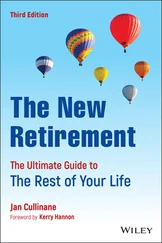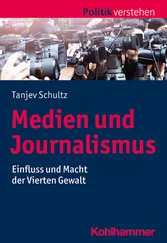Pension managers can’t just pull any number out of a hat; they generally use a rate based on long-term, high-grade corporate bonds to calculate their benefits obligations. But companies have some wriggle room, and even seemingly small differences can have a big impact. In 2009, for instance, Lockheed decreased its discount rate from 6.4 to 6.1 percent, which boosted its pension obligation by $1.7 billion.
Another key assumption is the “expected rate of return” on pension assets. This isn’t the assumption used to measure the size of the liability; it’s the assumption used to measure the pension plan’s impact on quarterly income. Odd as it may sound to people who hear about it for the first time, accounting rules permit pension managers to use hypothetical or “expected” returns on their pension assets—instead of the actual returns. This is intended to smooth out the impact of the investment returns, so that a year of large increases or decreases doesn’t affect earnings dramatically. This “smoothing mechanism,” which employers insisted on having when the rules were developed, gives companies a great deal of control over the amount of pension income or expense.
Researchers at Harvard University and MIT analyzed filings from more than 2,000 companies and found that companies near critical earnings thresholds had boosted their estimated returns the prior year. One of the companies was IBM. As its operating performance was deteriorating in 2000 and 2001, in the wake of the tech bubble bust, the company raised its expected return from 9.25 percent to 10 percent. The increase in the assumed return accounted for nearly 5 percent of IBM’s pretax income in 2000 and 2001.
The researchers also found that firms used higher expected returns on pension assets prior to acquiring other firms. “Managers may want to raise reported earnings… both to boost the price of stock that might be used as currency in such transactions and to generate greater bargaining power in the bidding process,” they concluded. In addition, they found that firms raise their assumed returns when they issue equity and when their managers exercise stock options.
Using expected returns to boost income isn’t the only way companies can use pensions to manage earnings, but these other ways have received little or no scrutiny. For example, underestimating the return on the pension assets can also render a benefit. For much of the nineties, the average expected rate of return companies used was 9 percent, even though returns were usually in the double digits, and exceeded 30 percent in some years. When the assumed (i.e., “expected”) return is lower than what the pension assets actually return, the excess gains—the amount that exceeds the expected returns—are set aside. Over time, companies add some of these excess gains into future years’ earnings calculations, a process called amortizing. By 2000, there were billions of dollars in “actuarial gains” sitting in reserves. When pensions had huge losses in the early 2000s, companies used these gains to cushion and delay the impact on earnings. (The reverse is also true: If losses are greater than the expected returns, the excess losses are parked on the sidelines and get added to the income calculations in subsequent years.)
Stuffing money into a pension plan is another way companies manage the timing and size of an income boost. When Lockheed Martin contributed $2 billion to its pension in 2010, the 8 percent expected return on assets guaranteed the aerospace-and-defense giant a $160 million boost to the bottom line in 2011, regardless of whether the company made any money selling jets. And because pension contributions are deductible, Lockheed was able to shave $64 million from its taxes.
The accounting and tax breaks explain why companies with well-funded pension plans happily shovel money into them. Why let a billion dollars in cash sit around unproductively when parking it in the pension can be so rewarding? Being able to park money in pension plans has so many rewards that employer groups have perennially lobbied to be allowed to put as much as they’d like into the plans. (Current law doesn’t let companies deduct contributions to pension plans once the level of assets reaches 150 percent of the plans’ liabilities.)
Companies also have a variety of reasons to adjust their assumptions to make their pension appear less well funded, or even terminally ill. This might be helpful prior to union negotiations or layoffs.
Mergers and acquisitions can offer companies an opportunity to monkey with the numbers. Prior to putting itself up for sale, a company may want to cut benefits or take other actions to make itself look more profitable.
Or perhaps it might want to sell some of the surplus. This was a common enough scenario that it was the topic of a panel at an annual actuaries conference in Colorado Springs in the summer of 1996. The panelists put on a skit involving a company that has asked its actuary to help increase the liability for the pensions of the transferred employees and retirees, so the company can justify transferring more assets than necessary and get cash in return, built into the sales price. The actuary does this, but is later called before a standards board and asked to justify the assumptions he used.
The “prosecutor,” played by the chief actuary at the American Academy of Actuaries, asks the actuary to defend his decision to use a 1951 mortality table to calculate the liability.
PROSECUTOR:Didn’t you choose these assumptions… so you could transfer as much money as possible to the buyer?
BAD ACTUARY:No, these are miners, so their life expectancy is not nearly as great as that of the general population.
PROSECUTOR:How much did you get for them in the purchase price? Is it 80 percent or 90 percent?
BAD ACTUARY:Well, it turned out that way in this transaction.
But he defends his actions saying he was just doing what his client wanted.
The skit concludes with the “prosecutor” telling the “bad actuary” that he’s done a good job. “Someday the PBGC is going to… make an example of somebody. So when you get involved in these areas, make sure you’re ready to answer all those questions. Have your answers ready.”
None of this was illegal, but it shows how routine these sales transactions were.
The pension income charade began to change after the market tanked in 2001. When the market was rising in the nineties, few analysts noticed that falling pension obligations and 30 percent investment returns were fluffing up profits, and companies didn’t go out of their way to call attention to it, preferring instead to let investors give company executives all the credit.
But when pension plans began losing money from 2000 through 2002, in part because managers had loaded them up with stock to boost pension income, companies quickly blamed the pension plans for their financial woes. Securities analysts who had been oblivious when pensions were pumping up income began cranking out reports dissecting the many ways pension plans were hurting earnings. These newly minted pension critics didn’t notice that companies could manage earnings by adjusting discount rates, dumping money into the plans, or cutting benefits. But they did notice that companies were using expected returns of between 8 percent and 10 percent. In 2002, for example, GM assumed a 10 percent return, even though assets actually lost 5.2 percent. Companies had been using the same 8 to 10 percent assumptions for years, including those when assets were earning 30 percent, but analysts acted as if they’d discovered the next Enron, and they cranked out even more reports. Even Warren Buffett, chairman of Berkshire Hathaway, weighed in, scolding companies for “legal but improper accounting methods used by chief executives to inflate reported earnings. The most flagrant deceptions have occurred in stockoption accounting and in assumptions about pension-fund returns. The aggregate misrepresentation in these two areas dwarfs the lies of Enron and WorldCom.”
Читать дальше












